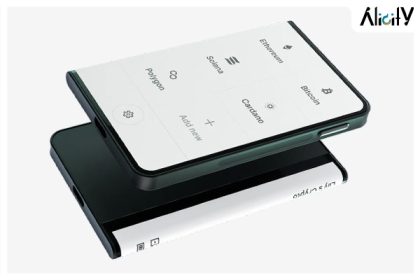Tezos It is one of those digital currencies that was able to establish its place in the crypto space. The name Tezos is familiar to everyone active in the digital currency community, and its coin, XTZ, has always been among the currencies with a high market value.
In this article, we will check that What is Tesos? And what unique features it has. We will also take a look at the uses and pros and cons of Tezos, its roadmap, how to buy, and XTZ wallets. Stay with us.
What is Tezos?
Tezos A blockchain is like Bitcoin and Ethereum, and its coin is XTZ It is also a digital currency like BTC and Ether. This blockchain is like Ethereum Contracts smart And applications Decentralized (DApps) supports; with the difference that it uses the proof-of-stake consensus algorithm and More scalable It is from Ethereum.
Tezos has introduced itself as the first self-correcting platform among cryptocurrencies. The Tezos smart contract platform is similar to Ethereum and allows the creation of decentralized applications. Of course, we mentioned that Tezos uses the Proof of Stake consensus algorithm. Participants in the Tezos blockchain, or shareholders, can vote on the changes they want so that a collective consensus can be reached on the network about the proposed plans.
Read more: What is a smart contract? How does Smart Contract work?
Characteristics of Tesos
On its site, Tezos has used the following basic features to describe its platform:
- self corrector
- Intra-chain management
- Decentralized innovation
- Smart contracts and formal review
- Proof of stock
- Representation
Self-Amendment: The self-correcting feature allows Tezos to apply its updates without the need to fork or separate chains into two different blockchains. This case is important because it can prevent the fragmentation of the society, the change of the motivations of the stakeholders and the disruption of the network over time. Due to the self-correcting feature of Tezos, the costs of updating the protocol and implementing innovations in the future are reduced.
On-Chain Governance: In Tezos, all stakeholders can be involved in protocol management. The electoral cycle is an organized process for shareholders to reach collective agreement on proposed plans. By combining the intra-chain management mechanism with the self-correcting protocol, it will be possible to change the voting process in the future by discovering better management mechanisms.
Decentralized Innovation: Proposed amendments that are accepted could include payments to groups or individuals who intend to improve the protocol. This type of funding mechanism makes it possible to maintain the network in a decentralized manner. Creating an ecosystem of active and diverse developers who have an economic incentive to participate in the protocol will improve the Tezos development and adoption process.
Smart Contracts & Formal Verification: The Tezos platform allows users to create smart contracts and decentralized programs that cannot be tampered with by third parties. In addition, Tezos helps the formal review process of smart contracts, which is a technique to improve their security. This technique, if used correctly, will prevent costly and controversial bugs in the future.
Read more: What are Decentralized Applications (DApps)? How is a decentralized application made?
Proof-of-Stake: Participants (nodes) in decentralized peer-to-peer networks provide computing resources necessary for the survival and continuation of the network. Unlike other proof-of-stake digital currencies, in Tezos any shareholder can participate in the consensus process and receive a reward from it for participating in the security and stability of the network. The barriers to entry in the Tezos mechanism are lower than others and its costs are also small compared to others.
Read more: What is Proof of Stake?
Delegation: A safe deposit is required to participate in the stock proof process. Just as proof of stake is based on the honesty of the majority of people in the network, Tezos' security is realized with its incentivizing protocol by punishing cheaters and rewarding honest people in the network. Users who do not want to directly participate in the consensus protocol are able to choose a proxy and delegate their rights to them.
Read more: What is Delegated Proof of Stake (DPoS)?
The Controversial History of Tesos
Tezos is the brainchild of Arthur Breitman, a computer specialist who published the Tezos White Paper (tezos.com/static/whitepaper) in August 2014 under the pseudonym LM Goodman. Subsequently, in the same year, Brittman founded a company called Dynamic Ledger Solutions in the state of Delaware and assumed the position of its CEO.
Arthur and his wife Kathleen, a former employee of Bridgewater Institute and R3, decided to hold an Initial Coin Offering (ICO) in order to raise funds to build the Tezos platform, after unsuccessfully attracting capital through traditional methods.
Read more: What is Initial Coin Offering or ICO? Attracting capital through digital currencies

The Tezos platform focuses on providing a decentralized democracy that allows its shareholders to run the network and steer it on-chain by leveraging proof-of-stake consensus.
Tezos raised $232 million in initial coin offering in July 2017 and Breitman founded the Tezos Foundation in Zug, Switzerland. Breitmann asked Johann Gevers to head the foundation. On the other hand, the Tezos Foundation was supposed to integrate the Brightman Dynamic Ledger Solution company along with the intellectual property of the Tezos source code.
But everything did not go according to plan and there were differences between Breitman and Gorz.
Essentially, the president and board member of the Tezos Foundation had control over the assets acquired by the ICO, and disagreements over who Gorz hired to run Tezos led to disputes.
The plan was that IPO tokens would be delivered to contributors and the Tezos blockchain would be launched as free software.
In addition, Brittman tried to sideline Gores, which eventually led to not only a public controversy between Brittman and Gores, but also a bitter rift between the Tezos community and Arthur's Corporation (DLS).

DLS, owned by Britman, soon came under regulatory pressure from the US Securities and Exchange Commission that Tezos tokens should be considered securities. It was also suggested that the funds be returned to the investors, but in the end the SEC did not agree to it.
Ultimately, Goers and the Tezos Foundation board voluntarily stepped down in February 2018, and were replaced by two Britman-backed activists, Michaelmani and Ryan Jefferson.
Few updates were made to Tezos over the next few months, much to the chagrin of their community.
Then in June 2018, the Tezos Foundation announced that ICO participants must complete Know Your Customer and Anti-Money Laundering (KYC/AML) policies. Of course, it must be said that this request was met with a negative reaction from the Tezos community.
How does Tezos work?
Tezos is a non-exclusive, distributed and self-correcting platform that uses smart contracts to provide a unique on-chain governance mechanism and some improvements over platforms like Ethereum. The main focus of the platform is on a multi-structure design with minor on-chain updates to the protocol, which uses a kind of modified proof-of-stake consensus model where stakeholders are able to change the governance structure of the protocol.
Network Shell
Tezos' unique governance and self-correcting capabilities are enabled through its network shell. To understand how the network shell works, we must divide the normal blockchain protocol into three main and distinct sub-protocols:
1. Network protocol: A network protocol, often referred to as a “discourse” protocol, specifies how transactions are communicated and propagated across the network between nodes (network participants). This protocol also includes how to download the blockchain, find or discover other nodes in the network and how to announce the found blocks to the network. In general, the network protocol has seen the most innovation and development activities.
Read more: What is Full Node?
2. Transaction protocol: The transaction protocol is defined by the scripting language of a digital currency and for Bitcoin it is the output model of unspent transactions or UTXO. To illustrate this sub-protocol in Bitcoin, it includes everything from the creation of new Bitcoins during the mining process to the use of digital signatures to verify transactions. Making changes to this subprotocol is commonly known as a soft fork, and often no other chain continues after they are applied.
Read more: What is a digital signature?
3. consensus protocol: This sub-protocol specifies how to reach a consensus (a collective agreement) between all the nodes of the blockchain network. Bitcoin uses Proof of Work as its consensus model. This protocol is vital to maintain the stability and authenticity of the blockchain; Because it determines how to prevent things like double spending and the immutability of the blockchain.
Read more: What is a double spend attack?
Applying changes to the consensus protocol is usually referred to as a hard fork, and often another chain is created after them. These types of hard forks cause fragmentation in cryptocurrency communities (such as Bitcoin and Bitcoin Cash), and Tezos aims to solve this problem with its design.
Read more: What is Bitcoin Cash and how does it work? Introduction to BCH

The Tezos network shell combines consensus and transaction protocols into what it calls the “Blockchain Protocol”. The blockchain protocol is a continuous set of agreed-upon improvements to the general state of the blockchain, where blocks are the main agents that change the state of the chain. For this reason, the blockchain protocol can examine itself and allow blocks to operate on the protocol. As a result, shareholders can directly influence system updates with their votes.
The network shell acts as an interface between the network protocol and the blockchain protocol. In fact, the task of the network shell is to maintain and provide the best known chain to the clients. Tezos is written in OCaml programming language and the network shell has the ability to identify blocks, transactions and protocols.
Ocmel language modules can be used to directly modify the current protocol. Also, the network shell prevents DDoS attacks to the network. In fact, the most important feature of the Tezos platform is the ability to implement protocols with their own modifiability feature.
The rule of Tesos
The governance of Tezos depends entirely on its shareholders (the holders of digital currency). All stakeholders can participate in protocol governance and vote on updates proposed by developers.
Although the initial voting mechanism is predefined, the governance process is such that the voting method can even be changed as the network progresses. There are many conditions that can change the protocol, the most important of which is the shareholders' vote.
However, more complex mechanisms can be applied through the governance model. For example, proving the legitimacy of the new changes compared to the extensive changes that have happened to most of the network members, which actually show the general principles of the platform and have been established by the stakeholders.
Liquid Proof of Stake
The implementation of Proof of Stake is an optimal combination of various concepts such as Slasher, Chain of Activity and Proof of Burn. Tezos uses a process called baking instead of mining. Blocks are created in this mechanism by shareholders; In this way, instead of solving a complex mathematical puzzle, they can create a new block when the XTZ token they have is randomly selected to create a block.
But there is no requirement for everyone to participate in this process. Users who do not intend to participate in voting can give their voting power by choosing a proxy for their coins. Bakers are notified a few weeks before voting begins to create Bond tokens, which are a dynamic deposit based on the number of blocks an agent has chosen to create.

If the bakers are honest, they will receive tokens as a reward, and if they are fraudulent (doing double spending, leading chain forks in different branches), their staked tokens will be confiscated as a punishment.
To start baking, a minimum of 8 GB of RAM, a stable Internet connection and a certain amount of Tezos tokens are required.
Uses of Tesos
According to all the contents that we have stated here, The most important uses of Tezos can be found in this 4 items Summarized:
- store of value: XTZ, like all other digital currencies including Bitcoin and Ethereum, is a digital currency that can be used for investment and as a store of value.
- Money transfer: All digital currencies can be used to transfer money, and Tezos is no exception.
- Launching smart contracts and decentralized applications: Since Tezos is a blockchain with the ability to support smart contracts, it can be used to run decentralized applications.
- shareholding: The Tezos blockchain is proof-of-stake, so users can stake their XTZ coins and get rewarded for contributing to the security of the network.
Read more: What is staking? Digital currency staking education
Advantages of Tezos digital currency
Tezos has been an overall successful blockchain and has achieved many of its goals well so far. The most important advantages of Tezos that can be mentioned are as follows:
- This blockchain prevents the implementation of hard forks;
- Every shareholder has the same voting right in this network;
- consumes less energy and is cost-effective;
- Its self-correction mechanism allows the automatic update of all system nodes;
- Its proof-of-stake algorithm rewards contributors in addition to increasing scalability, and this is a good incentive to contribute to securing the network;
- And the last and most obvious point is that it allows the implementation of decentralized programs.
Disadvantages of XTZ digital currency
The Tezos project, like any other project, can have its own disadvantages. Crypto experts often point out these 3 problems with Tezos:
- The waiting time for token distribution on Tezos is longer compared to other blockchains;
- So far, this blockchain has been exposed to various challenges and controversies and even legal charges;
- The concentration of wealth in Tezos is high, which is why some investors consider it risky.
The future of Tezos
With the year 2023 coming to an end, the Tezos team published their vision for the future of the project, especially in 2024, on the official website of the Tezos Foundation. In this text, it was determined how the Tezos budget will be distributed in 2024 and which areas will be prioritized. In this section, we will have a look at the text published on this website.
According to the Tezos Foundation, the team will focus heavily on the development of Tezos 2.0 in 2024. The release of the second version of Tezos is a great technological development for this blockchain. One million transactions per second, the addition of Etherlink, which is a second layer solution compatible with the Ethereum virtual machine, and the addition of smart rollups are just some of the advantages of this version.
Art and culture, DeFi, and gaming and entertainment are the areas that Tezos will focus more on in 2024. This blockchain has announced its desire to attract more developers and plans to implement this goal by providing more tools and better infrastructure. One of the most important goals of Tezos 2.0 is to enable support for all programming languages, including JavaScript and Python, thus opening the way to attract more developers.
Tezos Foundation also announced a fundamental revision in the way of investments and budget allocation. The team stated that they are “aware of and agree with the user community's request for more value investments.”
And finally, Tezos Foundation announced that one of their most important visions for 2024 is to be more active in social networks. They announced that they will dedicate a large part of their capacity in executive and operational teams to discussion forums and users can communicate with them through the link tezos.foundation/contact.
Buy Tezos (XTZ)
The best way to buy XTZ is to visit an Iranian digital currency exchange. Today, the number of these exchanges is much higher than in the past and the supported currencies are more diverse.
You can find a list of Iranian exchanges that support this currency by searching for the term “buy Tezos” on the Internet. You know that authentication is mandatory in Iranian exchanges; Therefore, if you have not registered and authenticated in any exchange before, you must do so first.
We also suggest to use Tezos purchase page of Erzdigital website. Authentication on this page is instant and by entering information such as national code and phone number, you will be redirected to the payment page and you can make your purchase.
Tezos (XTZ) price history
Tezos, which was added to some exchanges in the second half of 2017, experienced strong growth along with Bitcoin in December of the same year, and the value of each coin reached more than $10. Another significant growth that this digital currency showed and also increased the volume of transactions, took place in early 2019 and caused the price of Tezos to triple.

Tezos Wallet (XTZ)
To hold Tezos you must own its wallet or use wallets that support XTZ. For this purpose, Tezos has introduced four software options. It is also possible to store Tezos on Trezor and Ledger hardware wallets.
Read more: What is a hardware wallet? How to find a suitable hardware wallet?

Galleon wallet
If you plan to keep Tezos on your desktop, you can use the Galleon wallet, which is available for Windows, Linux, and Mac OS platforms.
Galleon wallet download link: galleon-wallet.tech

Frequently Asked Questions
Many of the wallets that support Tezos also allow for staking. Trust Wallet and Atomic Wallet are two of the most famous ones.
The highest price or the All-Time High of Tezos so far is $9.14.
The easiest way to buy Tezos is to use Iranian exchanges. Authentication in these exchanges is unimpeded for Iranian users and it is possible to convert Rial to XTZ.
RCO NEWS

















